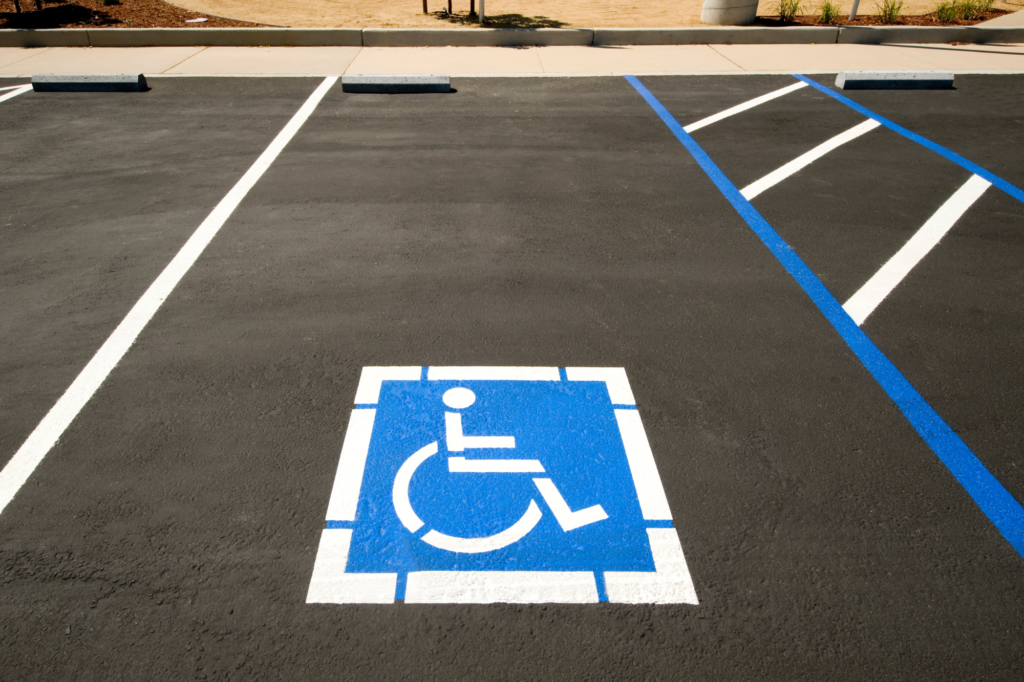Is Your Parking Lot Striping ADA Compliant?

1 in every 4 people in the United States has some form of disability. Even so, there are many places that are not handicap-accessible. This means that people are often left out and unable to access resources.
The ADA created regulations to make the world more accessible for people with disabilities. One set of regulations relates to ADA-compliant parking lot striping.
But what makes parking striping ADA-compliant? Let’s talk about it. Read on to learn more.
Appropriate Handicap Parking Space Dimensions
When it comes to standard parking spots, it is generally acceptable to make them as small as possible while still allowing the majority of cars to fit. Business owners try to maximize space, so they take up as little space as possible with each individual parking spot.
For ADA compliance, however, you must have specific measurements for accessible parking spots.
We are going to divide these into standard accessible parking spots and van-accessible parking spots.
There must be an adjacent access aisle next to each handicap-accessible parking spot. The spot should be boxed in and it should have diagonal stripes going through it. The spot itself should be 8 feet wide while the access aisle should be 5 feet wide.
For a van-accessible parking space, you still need an access aisle with diagonal stripes. You have two size options. You can either be a 9’ wide parking stall and an 8’ crosshatch or a 12’ wide parking stall and a 5’ crosshatch. Either way, the parking stall and crosshatch will need to be 17’ wide.
The goal is to give people plenty of room to safely exit their vehicles and use their mobility devices.
How Many Accessible Parking Spots Do You Need?
So how many accessible parking spots do you need? It depends on how large your parking lot is.
For up to 100 parking spots, you need at least one accessible parking spot per 25 parking spots. For example, if you have 75 total parking spots, 3 of those have to be handicap-accessible to maintain ADA compliance.
One of those spaces has to be a van-accessible space. 1 out of every 6 handicap-accessible spots must be van-accessible, but if you have fewer than 6, you still need at least one.
From 100 to 200 parking spots, you need an extra handicap-accessible parking spot for every 50 parking spots. For 200 to 500, you need an extra handicap-accessible parking spot for every 100 parking spots. After that, 2% of total parking spots should be accessible and 1 out of every 6 accessible spots should be van-accessible.
This gets more confusing as you increase the number of parking spots. If you run a medical facility, you may also need a larger percentage of ADA-compliant parking spots. When in doubt, talk to a professional.
Appropriate Handicap Parking Location
So where should these parking spots be? Handicap-accessible parking spaces should be as close as possible to building entrances. If there are multiple accessible entrances, there should be spaces close to every entrance.
If the closest space to the entrance is not on level ground, the closest level space should be handicap-accessible.
Do You Have ADA-Compliant Parking Lot Striping?
If you do not have ADA-compliant parking lot striping, you could find yourself in legal trouble. You are also doing a disservice to your clients and customers.
At Preferred Paving, we understand the ins and outs of ADA-compliant parking lots. We can help you make sure that your parking lot is accessible. Contact us for your pavement and asphalt needs today.
